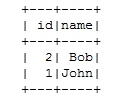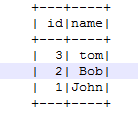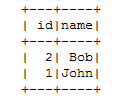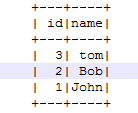PySpark Example Code¶
Prerequisites¶
A datasource connection has been created on the DLI management console.
CSS Non-Security Cluster¶
Development description
Code implementation
Import dependency packages.
from __future__ import print_function from pyspark.sql.types import StructType, StructField, IntegerType, StringType, Row from pyspark.sql import SparkSession
Create a session.
sparkSession = SparkSession.builder.appName("datasource-css").getOrCreate()
Connecting to data sources through DataFrame APIs
Set connection parameters.
resource = "/mytest" nodes = "to-css-1174404953-hDTx3UPK.datasource.com:9200"
Note
resource indicates the name of the resource associated with the CSS. You can specify the resource location in /index/type format. (The index can be the database and type the table.)
In Elasticsearch 6.X, a single index supports only one type, and the type name can be customized.
In Elasticsearch 7.X, a single index uses _doc as the type name and cannot be customized. To access Elasticsearch 7.X, set this parameter to index.
Create a schema and add data to it.
schema = StructType([StructField("id", IntegerType(), False), StructField("name", StringType(), False)]) rdd = sparkSession.sparkContext.parallelize([Row(1, "John"), Row(2, "Bob")])
Construct a DataFrame.
dataFrame = sparkSession.createDataFrame(rdd, schema)
Save data to CSS.
dataFrame.write.format("css").option("resource", resource).option("es.nodes", nodes).mode("Overwrite").save()
Note
The options of mode can be one of the following:
ErrorIfExis: If the data already exists, the system throws an exception.
Overwrite: If the data already exists, the original data will be overwritten.
Append: If the data already exists, the system saves the new data.
Ignore: If the data already exists, no operation is required. This is similar to the SQL statement CREATE TABLE IF NOT EXISTS.
Read data from CSS.
jdbcDF = sparkSession.read.format("css").option("resource", resource).option("es.nodes", nodes).load() jdbcDF.show()
View the operation result.

Connecting to data sources through SQL APIs
Create a table to connect to a CSS data source.
sparkSession.sql( "create table css_table(id long, name string) using css options( 'es.nodes'='to-css-1174404953-hDTx3UPK.datasource.com:9200', 'es.nodes.wan.only'='true', 'resource'='/mytest')")
Note
For details about the parameters for creating a CSS datasource connection table, see Table 1.
Insert data.
sparkSession.sql("insert into css_table values(3,'tom')")
Query data.
jdbcDF = sparkSession.sql("select * from css_table") jdbcDF.show()
View the operation result.

Submitting a Spark job
Upload the Python code file to DLI.
In the Spark job editor, select the corresponding dependency module and execute the Spark job.
Note
If the Spark version is 2.3.2 (will be offline soon) or 2.4.5, specify the Module to sys.datasource.css when you submit a job.
If the Spark version is 3.1.1, you do not need to select a module. Configure Spark parameters (--conf).
spark.driver.extraClassPath=/usr/share/extension/dli/spark-jar/datasource/css/*
spark.executor.extraClassPath=/usr/share/extension/dli/spark-jar/datasource/css/*
Complete example code
Connecting to data sources through DataFrame APIs
# _*_ coding: utf-8 _*_ from __future__ import print_function from pyspark.sql.types import Row, StructType, StructField, IntegerType, StringType from pyspark.sql import SparkSession if __name__ == "__main__": # Create a SparkSession session. sparkSession = SparkSession.builder.appName("datasource-css").getOrCreate() # Setting cross-source connection parameters resource = "/mytest" nodes = "to-css-1174404953-hDTx3UPK.datasource.com:9200" # Setting schema schema = StructType([StructField("id", IntegerType(), False), StructField("name", StringType(), False)]) # Construction data rdd = sparkSession.sparkContext.parallelize([Row(1, "John"), Row(2, "Bob")]) # Create a DataFrame from RDD and schema dataFrame = sparkSession.createDataFrame(rdd, schema) # Write data to the CSS dataFrame.write.format("css").option("resource", resource).option("es.nodes", nodes).mode("Overwrite").save() # Read data jdbcDF = sparkSession.read.format("css").option("resource", resource).option("es.nodes", nodes).load() jdbcDF.show() # close session sparkSession.stop()
Connecting to data sources through SQL APIs
# _*_ coding: utf-8 _*_ from __future__ import print_function from pyspark.sql import SparkSession if __name__ == "__main__": # Create a SparkSession session. sparkSession = SparkSession.builder.appName("datasource-css").getOrCreate() # Create a DLI data table for DLI-associated CSS sparkSession.sql( "create table css_table(id long, name string) using css options( \ 'es.nodes'='to-css-1174404953-hDTx3UPK.datasource.com:9200',\ 'es.nodes.wan.only'='true',\ 'resource'='/mytest')") # Insert data into the DLI data table sparkSession.sql("insert into css_table values(3,'tom')") # Read data from DLI data table jdbcDF = sparkSession.sql("select * from css_table") jdbcDF.show() # close session sparkSession.stop()
CSS Security Cluster¶
Development description
Code implementation
Import dependency packages.
from __future__ import print_function from pyspark.sql.types import StructType, StructField, IntegerType, StringType, Row from pyspark.sql import SparkSession
Create a session and set the AKs and SKs.
Note
Hard-coded or plaintext AK and SK pose significant security risks. To ensure security, encrypt your AK and SK, store them in configuration files or environment variables, and decrypt them when needed.
sparkSession = SparkSession.builder.appName("datasource-css").getOrCreate() sparkSession.conf.set("fs.obs.access.key", ak) sparkSession.conf.set("fs.obs.secret.key", sk) sparkSession.conf.set("fs.obs.endpoint", enpoint) sparkSession.conf.set("fs.obs.connecton.ssl.enabled", "false")
Connecting to data sources through DataFrame APIs
Set connection parameters.
resource = "/mytest"; nodes = "to-css-1174404953-hDTx3UPK.datasource.com:9200"
Note
resource indicates the name of the resource associated with the CSS. You can specify the resource location in /index/type format. (The index can be the database and type the table.)
In Elasticsearch 6.X, a single index supports only one type, and the type name can be customized.
In Elasticsearch 7.X, a single index uses _doc as the type name and cannot be customized. To access Elasticsearch 7.X, set this parameter to index.
Create a schema and add data to it.
schema = StructType([StructField("id", IntegerType(), False), StructField("name", StringType(), False)]) rdd = sparkSession.sparkContext.parallelize([Row(1, "John"), Row(2, "Bob")])
Construct a DataFrame.
dataFrame = sparkSession.createDataFrame(rdd, schema)
Save data to CSS.
dataFrame.write.format("css") .option("resource", resource) .option("es.nodes", nodes) .option("es.net.ssl", "true") .option("es.net.ssl.keystore.location", "obs://Bucket name/path/transport-keystore.jks") .option("es.net.ssl.keystore.pass", "***") .option("es.net.ssl.truststore.location", "obs://Bucket name/path/truststore.jks") .option("es.net.ssl.truststore.pass", "***") .option("es.net.http.auth.user", "admin") .option("es.net.http.auth.pass", "***") .mode("Overwrite") .save()
Note
The options of mode can be one of the following:
ErrorIfExis: If the data already exists, the system throws an exception.
Overwrite: If the data already exists, the original data will be overwritten.
Append: If the data already exists, the system saves the new data.
Ignore: If the data already exists, no operation is required. This is similar to the SQL statement CREATE TABLE IF NOT EXISTS.
Read data from CSS.
jdbcDF = sparkSession.read.format("css")\ .option("resource", resource)\ .option("es.nodes", nodes)\ .option("es.net.ssl", "true")\ .option("es.net.ssl.keystore.location", "obs://Bucket name/path/transport-keystore.jks")\ .option("es.net.ssl.keystore.pass", "***")\ .option("es.net.ssl.truststore.location", "obs://Bucket name/path/truststore.jks")\ .option("es.net.ssl.truststore.pass", "***")\ .option("es.net.http.auth.user", "admin")\ .option("es.net.http.auth.pass", "***")\ .load() jdbcDF.show()
View the operation result.

Connecting to data sources through SQL APIs
Create a table to connect to a CSS data source.
sparkSession.sql( "create table css_table(id long, name string) using css options(\ 'es.nodes'='to-css-1174404953-hDTx3UPK.datasource.com:9200',\ 'es.nodes.wan.only'='true',\ 'resource'='/mytest',\ 'es.net.ssl'='true',\ 'es.net.ssl.keystore.location'='obs://Bucket name/path/transport-keystore.jks',\ 'es.net.ssl.keystore.pass'='***',\ 'es.net.ssl.truststore.location'='obs://Bucket name/path/truststore.jks',\ 'es.net.ssl.truststore.pass'='***',\ 'es.net.http.auth.user'='admin',\ 'es.net.http.auth.pass'='***')")
Note
For details about the parameters for creating a CSS datasource connection table, see Table 1.
Insert data.
sparkSession.sql("insert into css_table values(3,'tom')")
Query data.
jdbcDF = sparkSession.sql("select * from css_table") jdbcDF.show()
View the operation result.

Submitting a Spark job
Upload the Python code file to DLI.
In the Spark job editor, select the corresponding dependency module and execute the Spark job.
Note
When submitting a job, you need to specify a dependency module named sys.datasource.css.
For details about how to submit a job on the DLI console, see
For details about how to submit a job through an API, see the modules parameter in
Complete example code
Connecting to data sources through DataFrame APIs
Note
Hard-coded or plaintext AK and SK pose significant security risks. To ensure security, encrypt your AK and SK, store them in configuration files or environment variables, and decrypt them when needed.
# _*_ coding: utf-8 _*_ from __future__ import print_function from pyspark.sql.types import Row, StructType, StructField, IntegerType, StringType from pyspark.sql import SparkSession if __name__ == "__main__": # Create a SparkSession session. sparkSession = SparkSession.builder.appName("datasource-css").getOrCreate() sparkSession.conf.set("fs.obs.access.key", ak) sparkSession.conf.set("fs.obs.secret.key", sk) sparkSession.conf.set("fs.obs.endpoint", enpoint) sparkSession.conf.set("fs.obs.connecton.ssl.enabled", "false") # Setting cross-source connection parameters resource = "/mytest"; nodes = "to-css-1174404953-hDTx3UPK.datasource.com:9200" # Setting schema schema = StructType([StructField("id", IntegerType(), False), StructField("name", StringType(), False)]) # Construction data rdd = sparkSession.sparkContext.parallelize([Row(1, "John"), Row(2, "Bob")]) # Create a DataFrame from RDD and schema dataFrame = sparkSession.createDataFrame(rdd, schema) # Write data to the CSS dataFrame.write.format("css") .option("resource", resource) .option("es.nodes", nodes) .option("es.net.ssl", "true") .option("es.net.ssl.keystore.location", "obs://Bucket name/path/transport-keystore.jks") .option("es.net.ssl.keystore.pass", "***") .option("es.net.ssl.truststore.location", "obs://Bucket name/path/truststore.jks") .option("es.net.ssl.truststore.pass", "***") .option("es.net.http.auth.user", "admin") .option("es.net.http.auth.pass", "***") .mode("Overwrite") .save() # Read data jdbcDF = sparkSession.read.format("css")\ .option("resource", resource)\ .option("es.nodes", nodes)\ .option("es.net.ssl", "true")\ .option("es.net.ssl.keystore.location", "obs://Bucket name/path/transport-keystore.jks")\ .option("es.net.ssl.keystore.pass", "***")\ .option("es.net.ssl.truststore.location", "obs://Bucket name/path/truststore.jks") .option("es.net.ssl.truststore.pass", "***")\ .option("es.net.http.auth.user", "admin")\ .option("es.net.http.auth.pass", "***")\ .load() jdbcDF.show() # close session sparkSession.stop()
Connecting to data sources through SQL APIs
# _*_ coding: utf-8 _*_ from __future__ import print_function from pyspark.sql import SparkSession import os if __name__ == "__main__": # Create a SparkSession session. sparkSession = SparkSession.builder.appName("datasource-css").getOrCreate() # Create a DLI data table for DLI-associated CSS sparkSession.sql("create table css_table(id int, name string) using css options(\ 'es.nodes'='192.168.6.204:9200',\ 'es.nodes.wan.only'='true',\ 'resource'='/mytest',\ 'es.net.ssl'='true',\ 'es.net.ssl.keystore.location' = 'obs://xietest1/lzq/keystore.jks',\ 'es.net.ssl.keystore.pass' = '**',\ 'es.net.ssl.truststore.location'='obs://xietest1/lzq/truststore.jks',\ 'es.net.ssl.truststore.pass'='**',\ 'es.net.http.auth.user'='admin',\ 'es.net.http.auth.pass'='**')") # Insert data into the DLI data table sparkSession.sql("insert into css_table values(3,'tom')") # Read data from DLI data table jdbcDF = sparkSession.sql("select * from css_table") jdbcDF.show() # close session sparkSession.stop()